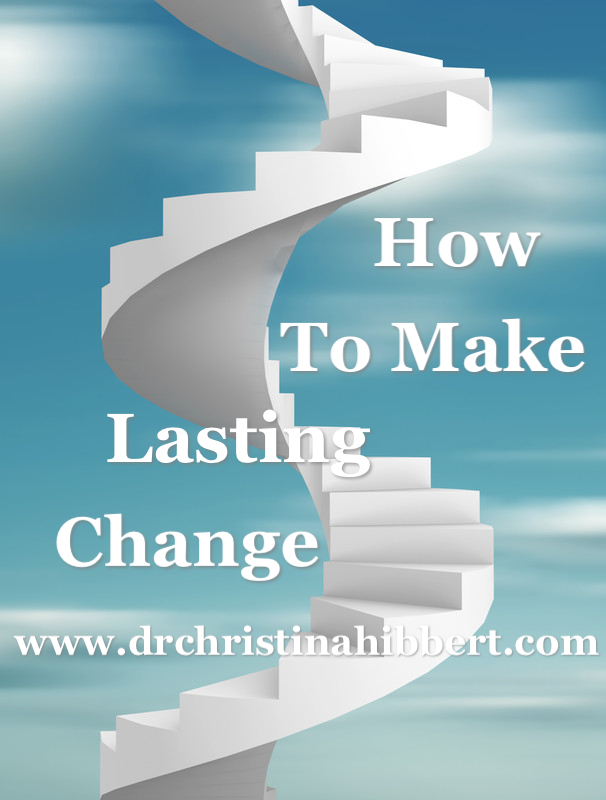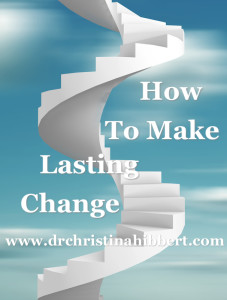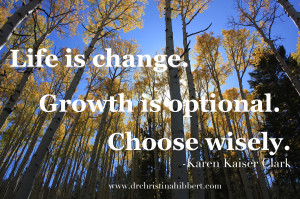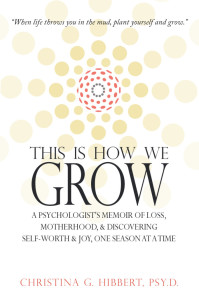
09 Nov How to Make Lasting Change: 5 Lessons from the Transtheoretical Model of Change that Will Change Your Life!
 5 Lessons from the Transtheoretical Model of Change that Will Change Your Life!
5 Lessons from the Transtheoretical Model of Change that Will Change Your Life!
Change is simply a fact of life. Just look at your body–do you still look, feel, or act like you did when you were an infant? Of course not! (Or, hopefully not the “act” part anyway). Our bodies change, our circumstances change, our relationships change. But are we choosing to change and progress in what we do, who we are, and how we are? Are we choosing to GROW?
Hopefully the answer is “Yes!” But, as enthusiastic as we may be about making positive change, it’s certainly not always easy, is it? In fact, one of the most frequent questions I get as a psychologist is “Why is it so hard to change?” I agree–it is hard to change, and for different reasons: Sometimes we don’t really feel convinced that change is needed, sometimes we know we need to change but aren’t sure how, and sometimes we are really trying to change and think we know how, but it’s just not sticking.
The Transtheoretical Model of Change
That’s where the Transtheoretical Model of Change (by James Prochaska, Ph.D.) comes in. Most of us think that change is just about  deciding to change and then changing. But what Prochaska teaches is that there are actually 6 stages involved in changing for good[1]! They are:
deciding to change and then changing. But what Prochaska teaches is that there are actually 6 stages involved in changing for good[1]! They are:
1) Precontemplation: “I don’t yet recognize I have a need for change.” Friends and family might be telling you that you need to change, and it might even have briefly crossed your mind, but you’re not yet convinced. (I like to joke that, right now, we’re all in the Precontemplation stage for something!)
2) Contemplation: “I know I need to change, but….” You realize the need for change, are thinking about it, but are not yet ready to make a plan or take action.
3) Preparation: “I will implement my plan for change within the next month.” As you prepare to take action, you may be doing research, gathering resources, and creating your plan for change.
4) Action: “I am actively working on making change.” This includes implementing your plan, evaluating your progress, and continuing to work hard.
5) Maintenance: “I’ve achieved the change I wanted, but now I need to make sure it stays that way.” In order for change to last, you need a plan for how you will maintain what has been gained.
6) Termination: “I am permanently changed. I no longer need a maintenance plan.” Truth is, most of us will never reach this stage for many of the changes we make. Even if your change really is lasting, most of the time it’s because you’re maintaining it well.
5 Lessons from the Transtheoretical Model of Change
Now, pay close attention as I outline 5 important lessons we can learn from the Transtheoretical Model of Change:
1) Simply deciding to change and changing is rare. You can’t expect things to change at the snap of your fingers—though it’s certainly been known to happen, it’s not likely. So, have some patience and give yourself a break.
 2) When you try to accomplish changes you’re not ready for, you set yourself up for failure. One of the biggest mistakes people make when trying to change is failing to admit they’re not ready. Change requires giving something up in order to gain something new and hopefully better. But, all change requires a loss: Even if we know we need to change, it can be tough to let go of our bad habits if for no other reason than they are comfortable, we’re used to them, they’re easy. It’s one thing to know you need to change; it’s another to really be ready to let yourself change.
2) When you try to accomplish changes you’re not ready for, you set yourself up for failure. One of the biggest mistakes people make when trying to change is failing to admit they’re not ready. Change requires giving something up in order to gain something new and hopefully better. But, all change requires a loss: Even if we know we need to change, it can be tough to let go of our bad habits if for no other reason than they are comfortable, we’re used to them, they’re easy. It’s one thing to know you need to change; it’s another to really be ready to let yourself change.
3) If you want successful change, you need to know which stage you’re in. Too many of us jump into the “action” stage before we’re ready. Taking time to analyze which stage you’re actually in can dramatically improve your success!
4) The 6 Stages of Change work like a spiral staircase, and most people spiral several times.Most self-changers cycle up and down the spiral several times before change sticks. Moving up, down, and back up in the spiral of change is all part of the process.
5) As long as you are in the spiral, you are progressing—it doesn’t matter which way you are headed!Research shows that people who take action but “fail” within the next month are twice as likely to succeed over the next 6 months than those who don’t take action at all! Prochaska calls this “recycling.” For example, starting a strict diet and losing 20 pounds only to gain 10 more back may feel like a failure. But, as long as you recycle to the Preparation stage—to create a new plan of action—you’re still succeeding. After all, without the “failure” of the strict diet plan, you might never have taken Action with the “healthy diet and exercise” plan that eventually moves you to “Maintenance”! Success is staying in the spiral.
Choose to Change–Choose to Grow!
I love the Transtheoretical Model of Change—it helps me see that change really is more complex than I once believed; it helps me understand what to focus on in order to change myself and choose to grow, it helps me let go of the frustrations I feel when change isn’t happening quickly enough, and it helps me see that maybe what I once thought of as “failures” are just steps on my way to the top of the spiral! Learning this model has changed my life—literally—and I hope it will do the same for you.
Do you ever find it difficult to change? If so, why do you think that is? What advice would you give others for making lasting change? What do you think of the lessons from the Transtheoretical Model? Leave a comment below and get the conversation started!
Be sure to check out Dr. Hibbert’s Amazon Bestseller, This is How We Grow–
available now on Amazon.com!
Join my This is How We Grow Personal Growth Group!
FREE. Online. Growth. What more could you ask for?
Don’t miss a thing!
SUBSCRIBE, just below, “like” my Facebook pages (Dr. Christina Hibbert; This Is How We Grow), and follow me on Twitter,Pinterest, & Instagram!
You may manage your subscription options from your profile
Related Articles:
10 Major Mistakes I’ve Made This Month & Why It’s OK
Learning Self-Love: 5 Tricks for Treating Yourself More Kindly
Resources:
[1] Prochaska, J., et al. (1994). Changing For Good: A revolutionary six-stage program for overcoming bad habits and moving your life positively forward. Collins Living: New York, NY.


Change requires aspects of safety and security within your own self and if this is not apparent; the chance of change becomes less.
Change happens on different levels; consciously and subconsciously and the recognition of the need for change can be hard.
You may have the best will in the world to change; but the saying “actions speak louder then words” comes into play.
I very much enjoyed the article and I see the purpose and relevance and hopefully this may assist me in the future.
Thanks Josie
Thank you, Josie. I completely agree. We must feel secure in desiring and being able to achieve change, before it will occur. And, change definitely is not easy! I do hope this model is helpful to you as you face your future changes. Best to you!
Dr. Hibbert,
It is so frustrating knowing that I am trying to change yet I doubt or questions myself if I’m really changing or in other terms, my therapist guided me as a horse to the water, it is up to me if I want to drink the water. I wonder if I’m actually drinking the water or not. It has been probably the most exhausting process I ever been through. I love my therapist to death yet I wonder if it’s working. At least I embrace the term, “process” and she smiles every time! 🙂